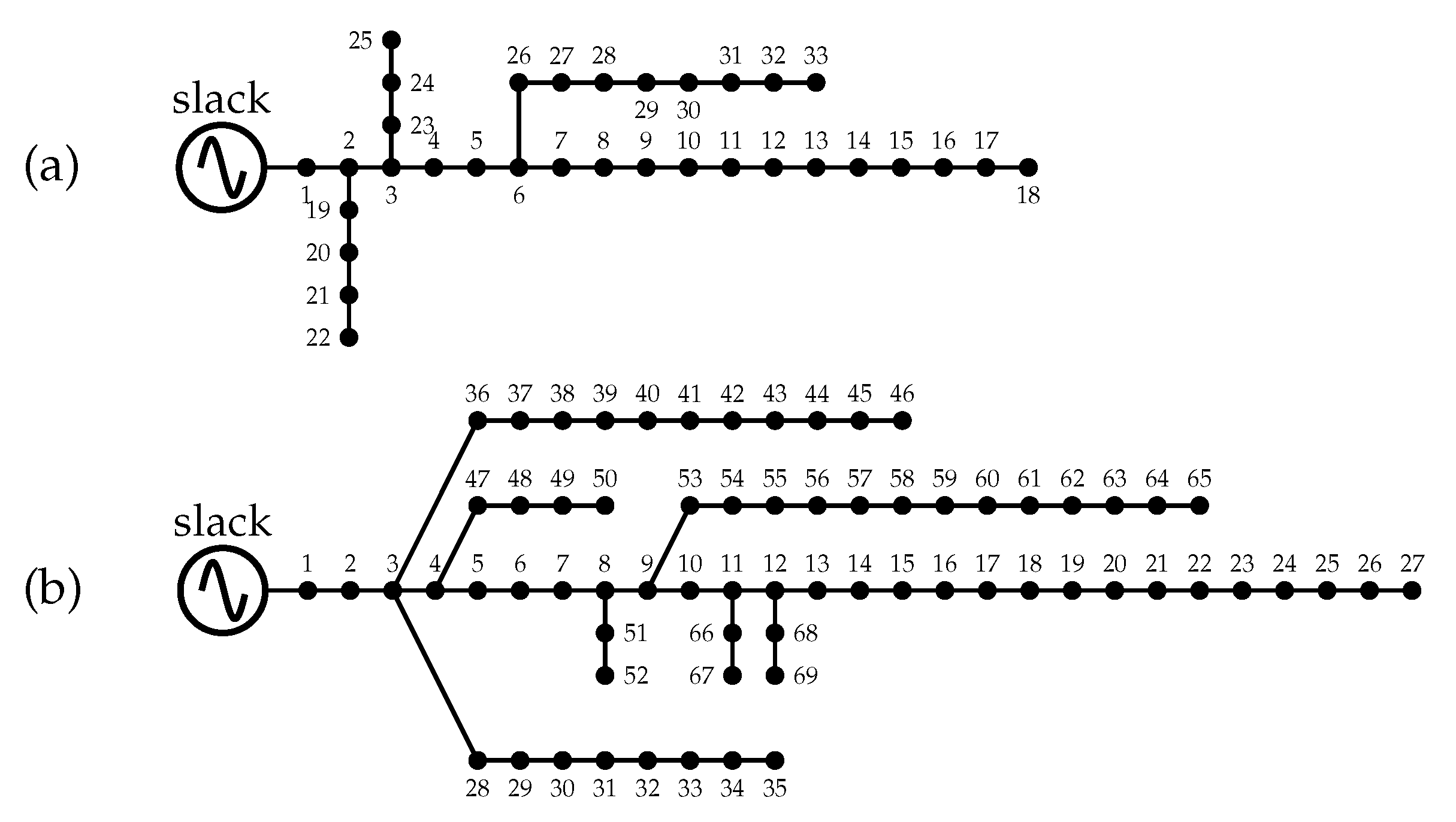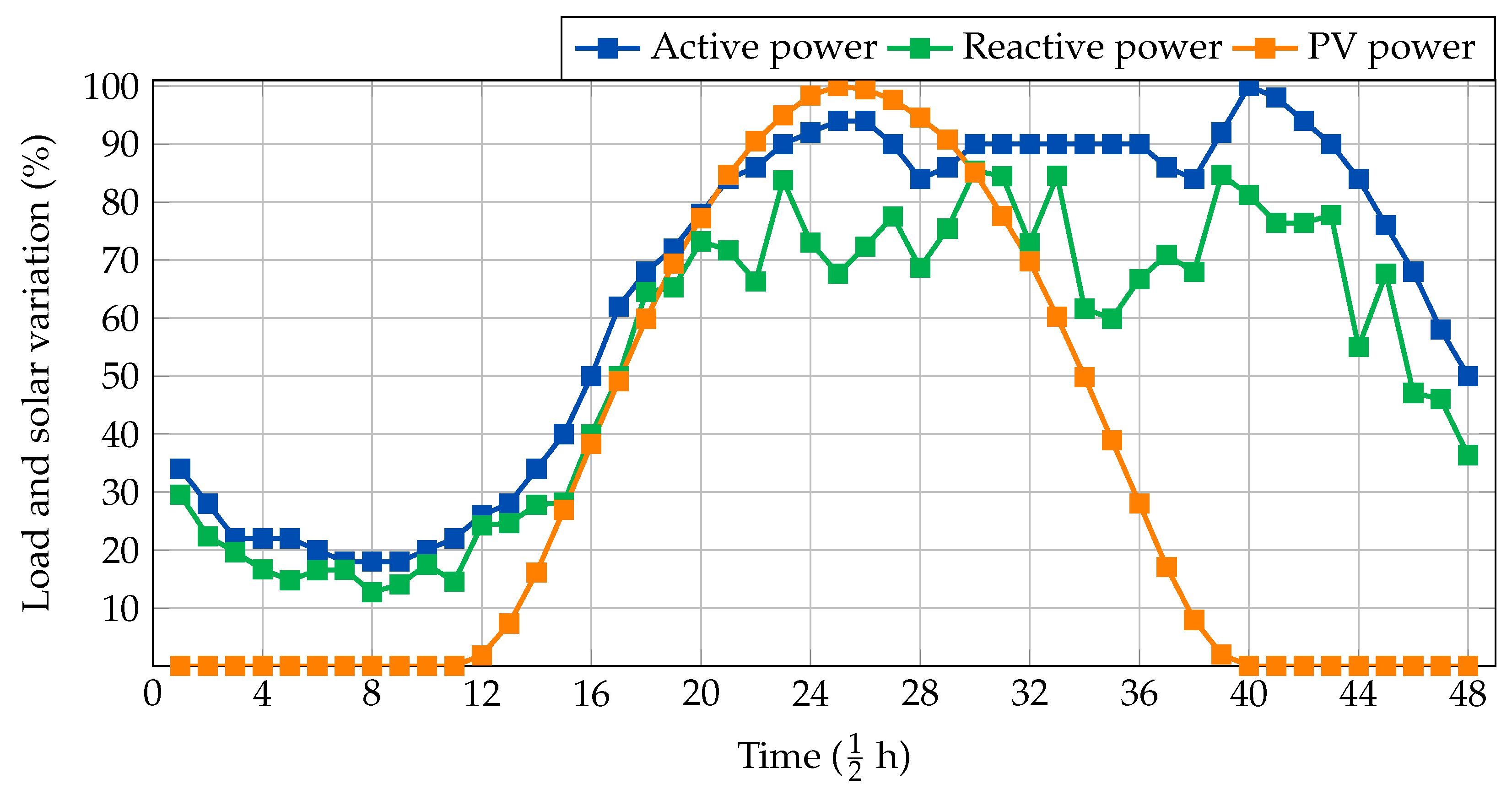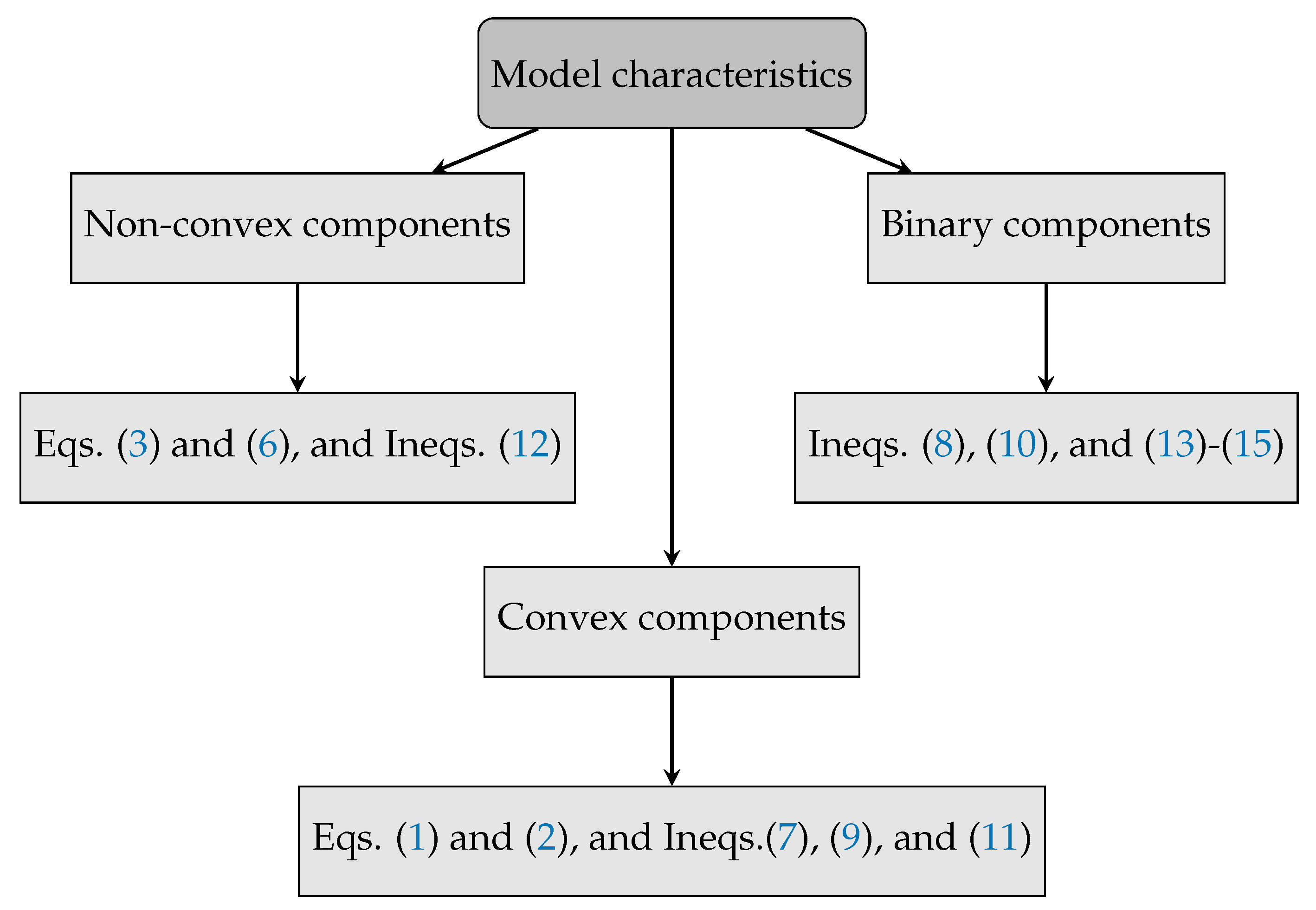1.1. General Context
The increasing demand for electrical energy and the need to reduce carbon emissions have driven the integration of renewable sources into power systems [
1,
2,
3]. In this context, photovoltaic solar (PV) energy has emerged as a key alternative due to its availability, modularity, and steadily decreasing costs [
4,
5,
6]. However, the large-scale penetration of PV generation introduces new operational challenges in distribution networks, such as voltage fluctuations, increased technical losses, and line congestion [
7,
8]. To mitigate these effects, renewable generation must be complemented with reactive power compensation technologies, e.g., distribution static synchronous compensators (D-STATCOMs), which help to improve voltage stability and power quality [
9,
10]. However, implementing these devices requires appropriate planning strategies that balance technical feasibility and economic viability [
11].
The integration of these resources poses both technical and economic challenges, as improper placement and sizing can negatively impact power supply quality and system profitability [
12,
13]. In this context, it is essential to develop optimization methodologies that enable efficient integration while ensuring maximum utilization of the available resources as well as sustainable grid management [
14]. The problem regarding the optimal integration of PV generators and D-STATCOMs belongs to the family of mixed-integer nonlinear programming (MINLP) models that simultaneously consider investment, operating, and maintenance costs in addition to the technical constraints of the grid.
1.2. Motivation
In today’s energy landscape, the growing demand for and transition towards more sustainable electrical systems have driven the adoption of distributed renewable sources, particularly PV energy [
15,
16]. However, the large-scale integration of these resources into traditional distribution networks, originally designed for unidirectional power flow, presents operational challenges such as voltage fluctuations, network element overloads, and increased technical losses [
17,
18]. In this context, optimizing the placement and sizing of PV generators and reactive power compensation devices becomes a crucial factor in ensuring an efficient and economically viable energy transition, underscoring the integration of PV generators, D-STATCOMs, and other measurement devices into the electrical infrastructure as a vital part of the process.
The implementation of strategies for the integration of PV generators and D-STATCOMs not only improves the efficiency of distribution power systems but also provides economic and environmental benefits. Furthermore, promoting more efficient use of distribution infrastructure encourages the development of distributed generation projects in non-interconnected or isolated areas, fostering rural electrification and reducing dependence on fossil fuels [
19,
20]. In this regard, this study aims to provide optimization tools that support strategic planning aligned with energy policies and global sustainability commitments.
1.3. Literature Review
The following is an analysis of the main studies published in the last five years in relation to the placement and sizing of PV generators and D-STATCOMs.
In [
21], the authors presented a hybrid analytical and metaheuristic optimization methodology for siting and sizing PV generators and D-STATCOMs in distribution networks, aiming to minimize losses and improve voltage profiles. They employed particle swarm optimization (PSO), combined with Monte Carlo simulation, to model probabilistic demand. Validations conducted in a real distribution network in southern Kerman showed improvements in voltage profiles and reductions in active and reactive power losses. However, PSO does not guarantee a global optimum and may suffer from premature convergence. Additionally, while Monte Carlo simulation helps to model demand uncertainty, it increases computational complexity without necessarily enhancing the solution quality.
The authors of [
22] proposed an approach based on the rat swarm optimization (RSO) algorithm for the optimal siting and sizing of PV generators and D-STATCOMs in distribution networks, with the purpose of minimizing active power losses, improving voltage profiles, and reducing voltage deviation. The methodology was validated on the IEEE 33-node system, showing reductions in power losses ranging from 210.996 kW to 26.155 kW and an improved minimum voltage of 0.98 p.u. with the simultaneous integration of the aforementioned devices. However, while RSO is a robust metaheuristic technique, it does not guarantee global optimality and can be affected by initialization quality and premature convergence.
The study by [
20] presented an approach based on the black widow optimization (BWO) algorithm for the optimal siting and sizing of PV generators and D-STATCOMs in radial distribution networks, whose objective function aimed to minimize power losses and improve voltage profiles. When applied to the IEEE 12-, 33-, and 69-node systems, the method demonstrated significant loss reductions and voltage stability improvements, achieving a reduction of up to 96% in active power losses in some cases. However, while BWO enables the exploration of multiple solutions, it is a metaheuristic technique that does not guarantee global optimality and is sensitive to parameter initialization. Additionally, the study did not explicitly address the investment and operating costs, thereby limiting its applicability in scenarios where economic feasibility is a key factor for distribution network planning.
In [
23], the problem regarding the optimal siting and sizing of distributed generators and D-STATCOMs in distribution networks was addressed using the grasshopper optimization algorithm (GOA). In this model, the objective function sought to minimize active power losses and improve the voltage stability index (VSI) of the grid. To validate this method, the IEEE 33-node system was used, achieving an 81.5% reduction in power losses and a 30.7% increase in the VSI when considering multiple DGs and D-STATCOMs. Despite its advantages, however, as a metaheuristic technique, the GOA cannot guarantee convergence to the global optimum. Additionally, this methodology did not incorporate explicit economic constraints in the objective function, which may limit its applicability in scenarios where investment and operating cost optimization is a key factor.
The authors of [
24] developed a methodology based on the modified horned lizard optimization algorithm (MHLOA) for the optimal siting and sizing of PV systems and D-STATCOMs in distribution networks while considering uncertainty. The objective function aimed for cost minimization, emissions reduction, voltage deviation mitigation, and active power loss reduction. This approach was validated on the IEEE 33-node system, exhibiting significantly reduced annual costs, power losses, and pollutant emissions. Despite its comprehensive approach, the MHLOA also does not guarantee convergence to the global optimum and may be affected by premature convergence or sensitivity to the initial parameters. Additionally, while this study accounted for uncertainty in load, pricing, and solar irradiance, it did not analyze the problem’s convexity or provide theoretical guarantees of optimality, which may limit the accuracy and reliability of planning in more demanding scenarios.
In [
25], the authors proposed a methodology based on the GOA for the optimal reconfiguration of distribution networks in the presence of D-STATCOMs and PV generators. The objective function focused on minimizing power losses and improving voltage profiles in radial distribution networks under different load conditions. This method was validated on the IEEE 33-, 69-, and 118-node systems, achieving significant loss reductions and voltage stability improvements when compared with previous approaches like the modified pollination algorithm and the fuzzy ant colony optimization algorithm. Despite the results obtained, this study primarily dealt with loss reduction and voltage profile improvement without explicitly considering investment and operating cost minimization—a crucial factor in planning distribution networks with distributed energy resources.
The authors of [
26] presented an approach based on the modified antlion optimizer (MALO) for the optimal siting and sizing of PV generators and D-STATCOMs in radial distribution networks while also considering network reconfiguration. The objective function focused on minimizing power losses, improving the voltage profile, and reducing the system’s operating costs. This methodology was validated on the IEEE 118-node system and a real 317-node network belonging to BESCOM (India), achieving power loss reductions of 41.47% in the IEEE system and 59.34% in the 317-node network while using a ZIP load model. Although the proposed methodology significantly improves loss reduction and voltage stability, its metaheuristic approach does not ensure global optimality. In scenarios where economic feasibility and theoretical optimality are critical, exact optimization approaches can provide greater reliability and efficiency in distribution network planning.
The work by [
27] employed the sech-tanh optimization algorithm (STOA) to optimize the issue under study, with the objective of minimizing investment and operating costs via a MINLP model. This method was validated on the IEEE 33- and 69-node systems, showing reductions of up to 35.68% in the objective function value, outperforming methodologies such as the VSA and the sine-cosine algorithm (SCA). However, as a metaheuristic method, the STOA does not ensure global optimality and its performance may be affected by parameter selection.
Meanwhile, in [
11], an MINLP-based model was developed for the simultaneous integration of PVs and D-STATCOMs while aiming to minimize the annual investment and operating costs. The authors employed the VSA in conjunction with successive power flow calculations and validated their approach on the IEEE 33- and 69-node systems. The results showed cost reductions of up to 35.53%, demonstrating the effectiveness of simultaneous integration when compared with the independent installation of each device. However, since this is a heuristic approach, the obtained solution is not guaranteed to be globally optimal and may suffer from convergence issues.
The reviewed literature highlights the significant advancements made in optimizing the integration of PVs and D-STATCOMs in distribution networks. Most studies employ metaheuristic approaches (e.g., PSO, RSO, BWO, the GOA, the MHLOA, MALO, the STOA, and the VSA), demonstrating their effectiveness in reducing power losses, improving voltage profiles, and, in some cases, optimizing investment and operating costs. However, a common limitation across these works lies precisely in their reliance on heuristic methods, which, despite their flexibility and efficiency in solving complex problems, do not guarantee global optimality and can be sensitive to parameter selection and initialization.
A major gap in the literature is the lack of methodologies that ensure theoretically optimal solutions while maintaining computational efficiency. Although some studies incorporate economic considerations, they often fail to address the convexity of the problem or provide guarantees of optimality, which limits their applicability in real-world planning scenarios where investment and operating costs play a crucial role.
1.4. Novelty and Main Contributions
This article presents a significant opportunity to address the aforementioned limitations by introducing a mixed-integer convex (MI-convex) optimization approach. This MI-convex model ensures a global optimum for the problem, which is not possible with metaheuristic methods, and it is obtained by transforming a traditional MINLP formulation into a mixed-integer convex equivalent through the second-order relaxation of the nodal voltage products. Our proposal improves upon the results reported in [
27] in determining the placement and sizing of PVs and D-STATCOMs.
This work advances the state of the art by addressing several limitations identified in previous research and contributing to the field in the following ways:
- i.
The proposed MI-convex model can guarantee a global solution, unlike traditional metaheuristic methods based on stochastic processes that may converge to suboptimal solutions.
- ii.
The MI-convex formulation offers greater computational efficiency compared with the MINLP model since its non-convex constraints are relaxed, allowing exact methods to operate efficiently and achieve faster convergence.
It should be emphasized that this study focuses on the optimal placement and sizing of PV units and D-STATCOMs in distribution networks using a MI-convex formulation, seeking to demonstrate the global optimality guarantee offered by convex relaxation techniques. However, the current formulation does not explicitly incorporate network branch capacity constraints, such as thermal or ampacity limits, which are critical to ensuring the secure and reliable operation of the system. While the proposed method provides valuable insights into the optimal distribution of generation and reactive support, further research is required in order to extend the model to account for these physical and operational limits while ensuring the practical feasibility of the solutions.













